
The New Zealand dollar is the official currency and legal tender of New Zealand, the Cook Islands, Niue, the Ross Dependency, Tokelau, and a British territory, the Pitcairn Islands. Within New Zealand, it is almost always abbreviated with the dollar sign ($). The abbreviations "$NZ" or "NZ$" are used when necessary to distinguish it from other dollar-denominated currencies.

The Fijian dollar has been the currency of Fiji since 1969 and was also the currency between 1867 and 1873. It is normally abbreviated with the dollar sign $, or alternatively FJ$ to distinguish it from other dollar-denominated currencies. It is divided into 100 cents.
The tālā is the currency of Samoa. It is divided into 100 sene. The terms tālā and sene are the equivalents of the English words dollar and cent in the Samoan language. Its symbol is $, or WS$ to distinguish it from other currencies named dollar.

The pound was the currency of Southern Rhodesia from 1964 to 1965 and Rhodesia from 1965 until 1970. It was subdivided into 20 shillings, each of 12 pence.

The Cook Islands dollar was the former currency of the Cook Islands, which now uses the New Zealand dollar, although some physical cash issued for the Cook Islands dollar remains in use. The dollar was subdivided into 100 cents, with some older 50-cent coins carrying the denomination as "50 tene".
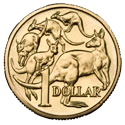
The Australian one-dollar coin is the second most valuable circulation denomination coin of the Australian dollar after the two-dollar coin; there are also non-circulating legal-tender coins of higher denominations.
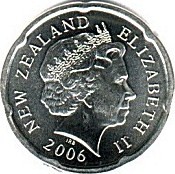
The New Zealand twenty-cent coin is the second-lowest-denomination coin of the New Zealand dollar. The 20-cent coin was introduced when the New Zealand dollar was introduced on 10 July 1967, replacing the New Zealand florin coin. Its original reverse of a kiwi was changed in 1990 when the image was moved onto the one-dollar coin. In 2006 its size was reduced and its edge altered to a Spanish flower as part of a revision of New Zealand's coins, which also saw its alloy become nickel-plated steel instead of cupro-nickel.
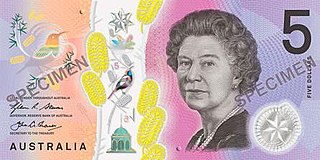
The Australian five-dollar note was first issued on 29 May 1967, fifteen months after the currency was changed from the pound to the dollar on 14 February 1966. It was a new denomination with mauve colouration – the pre-decimal system had no denomination with a value of £21⁄2. The first polymer version of the note was introduced on 7 July 1992. A major design update was issued on 1 September 2016, with a minor update to the signatures in 2019.
The coins of the Australian dollar were introduced on 14 February 1966, although they did not at that time include the one-dollar or two-dollar coins. The dollar was equivalent in value to 10 shillings in the former currency.
The coins of the New Zealand dollar are used for the smallest physical currency available in New Zealand. The current denominations are ten cents, twenty cents, fifty cents, one dollar and two dollars. The $1 and $2 coins are minted in a gold colour, the 20c and 50c coins are silver colour and the 10c coin is plated in copper.
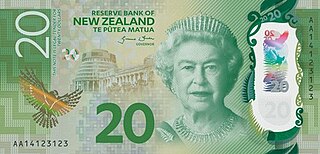
The New Zealand twenty-dollar note is a New Zealand banknote. It is issued by the Reserve Bank of New Zealand and since 1999 has been a polymer banknote. It was first issued on 10 July 1967 when New Zealand decimalised its currency, changing from the New Zealand pound to the New Zealand dollar. It has an image of Queen Elizabeth II on the front.
New Zealand dollar banknotes are the banknotes in circulation in New Zealand, the Cook Islands, Tokelau, Niue and the Pitcairn Islands, denominated in the New Zealand dollar. They are issued by the Reserve Bank of New Zealand and since 1999 have been made of polymer.

The New Zealand one-dollar coin ($1) is a coin of the New Zealand dollar. The current circulating coin was introduced on 11 February 1991 to replace the existing $1 note. There had previously been occasional issues of commemorative "silver dollars", but they are rarely seen in circulation.
The New Zealand two-dollar coin is the largest-denomination coin of the New Zealand dollar. It was introduced along with the one-dollar coin in 1990. Both are made from an alloy of aluminium and brass. It is the largest and heaviest coin in circulation, weighing ten grams and measuring 26.5 millimetres in diameter. Its thickness is 2.7 mm, only 0.4 mm thinner than the one-dollar coin, thus it is the second-thickest coin in the country's circulation. Both the $1 and $2 coins are gold-coloured, and requests for a Koha, donation or entry fee sometimes say gold coin please.

The New Zealand five-dollar note is a New Zealand banknote. It is issued by the Reserve Bank of New Zealand and since 1999 has been a polymer banknote. It was first issued on 10 July 1967 when New Zealand decimalised its currency, changing from the New Zealand pound to the New Zealand dollar. The note originally had an image of Queen Elizabeth II on the front; since 1992 it has had an image of Sir Edmund Hillary. The new design released in October 2015 was named "Banknote of the Year" by the International Bank Note Society for 2015.

The New Zealand ten-dollar note is a New Zealand banknote. It is issued by the Reserve Bank of New Zealand and since 1999 has been a polymer banknote. It was first issued on 10 July 1967 when New Zealand decimalised its currency, changing from the New Zealand pound to the New Zealand dollar. The ten-dollar note originally had an image of Queen Elizabeth II on the front; since 1991 it has had an image of suffragist Kate Sheppard.
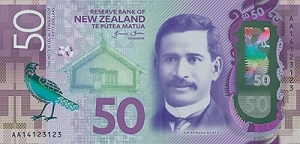
The New Zealand fifty-dollar note is a New Zealand banknote. It is issued by the Reserve Bank of New Zealand and since 1999 has been a polymer banknote. It was first issued in 1983. The note originally had an image of Queen Elizabeth II on the front; since 1992 it has had an image of Sir Āpirana Ngata.

The New Zealand one-hundred-dollar note is a New Zealand banknote. It is issued by the Reserve Bank of New Zealand and since 1999 has been a polymer banknote. It was first issued on 10 July 1967 when New Zealand decimalised its currency, changing from the New Zealand pound to the New Zealand dollar. The note originally had an image of Queen Elizabeth II on the front; since 1992 it has had an image of Ernest Rutherford.

The New Zealand one-dollar note was introduced on 10 July 1967 as part of the Reserve Bank of New Zealand’s third issue round. The third issue round was the first round in which the official currency was denominated in dollars and utilised the decimal system. First issue and second issue rounds were valued in pounds and utilised the imperial system. The one dollar-note was officially removed from circulation in 1991, along with the two-dollar note, as one-dollar and two-dollar coins had commenced production the previous year.
Four banknotes of the Canadian dollar have been commemorative issues. The first was issued in 1935 to the silver jubilee of the accession of George V to the throne of the United Kingdom, the only $25 banknote ever issued by the Bank of Canada. The second commemorative banknote was the Centennial $1 banknote issued in January 1967 to commemorate the Canadian Centennial. The third was issued in September 2015 to commemorate Elizabeth II becoming the longest-reigning monarch of the United Kingdom and Canada. In 2017, the Bank of Canada released a commemorative $10 banknote for Canada's sesquicentennial, which was available by Canada Day.














